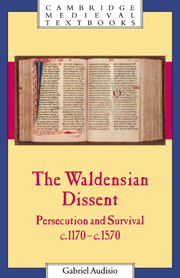Book contents
- Frontmatter
- Contents
- List of maps
- Preface
- Acknowledgements
- Introduction
- 1 1170 – 1215: decisive and purposive origins
- 2 The thirteenth century: the need to adapt
- 3 The fourteenth century: the challenge of believing differently
- 4 The fifteenth century: the risks of longevity
- 5 The constraints of a life in hiding
- 6 The need to organise
- 7 A culture of their own: the written and the spoken word
- 8 The sixteenth century: the end as a way forward?
- 9 Epilogue: the Waldensian Church
- Conclusion
- Bibilography
- Index
- Cambridge Medieval Textbooks
2 - The thirteenth century: the need to adapt
Published online by Cambridge University Press: 05 June 2012
- Frontmatter
- Contents
- List of maps
- Preface
- Acknowledgements
- Introduction
- 1 1170 – 1215: decisive and purposive origins
- 2 The thirteenth century: the need to adapt
- 3 The fourteenth century: the challenge of believing differently
- 4 The fifteenth century: the risks of longevity
- 5 The constraints of a life in hiding
- 6 The need to organise
- 7 A culture of their own: the written and the spoken word
- 8 The sixteenth century: the end as a way forward?
- 9 Epilogue: the Waldensian Church
- Conclusion
- Bibilography
- Index
- Cambridge Medieval Textbooks
Summary
The faltering beginnings of the Poor of Lyons and their first efforts to find a new place within the Church and the society of the time gave way to a situation they were not prepared for and which they had not foreseen. Once rejected by a Church hierarchy they had tried to appease, they were left with the choice either of retracting by giving up their evangelical mission to preach, or of going into hiding to remain faithful to their apostolic vocation. As has been seen above, however, their position was not as straightforward as this, nor was the situation so clear at this point, even after the anathema of 1215. As the reader will have realised, the date of 1215 has been taken as a pivotal point between the two chapters mainly for practical reasons. This is not to deny the significance of the official, solemn and definitive condemnation of the Poor of Lyons; it did indeed change the fate of the Waldensian movement altogether. But it is too easy to overlook the fact that, essential as laws, regulations and other normative texts may be, the difference between theory and practice can be great. It should be recalled that after the Council of Verona in 1184, and even after the Fourth Lateran Council in 1215, many Christians continued to listen in public to the preachers of poverty, many clerics went on discussing and debating with them, even going so far as to defend them, and many Poor of Lyons considered themselves not only to be members of the Church of Christ but also faithful to the Church of Rome.
- Type
- Chapter
- Information
- The Waldensian DissentPersecution and Survival, c.1170–c.1570, pp. 26 - 39Publisher: Cambridge University PressPrint publication year: 1999

